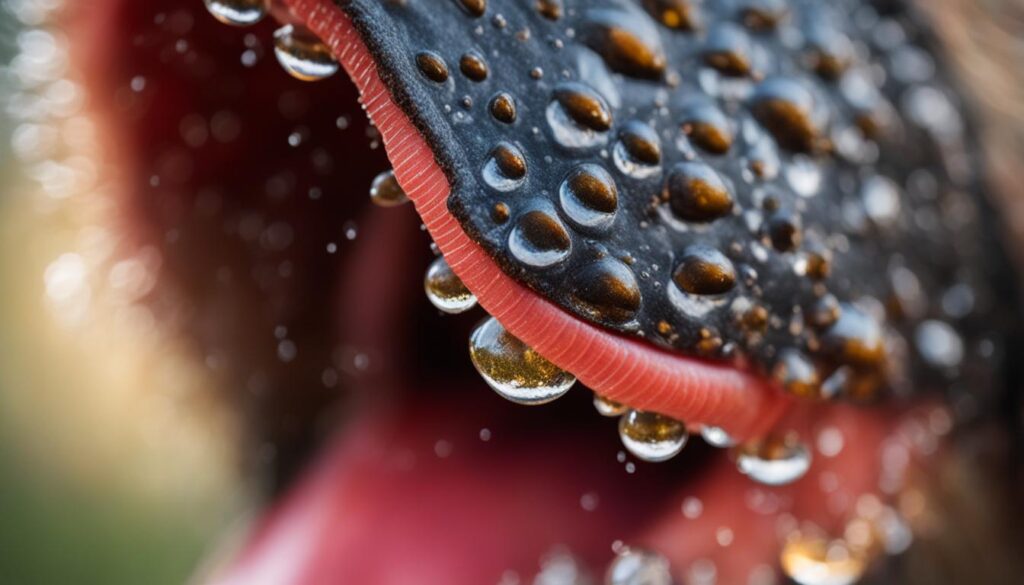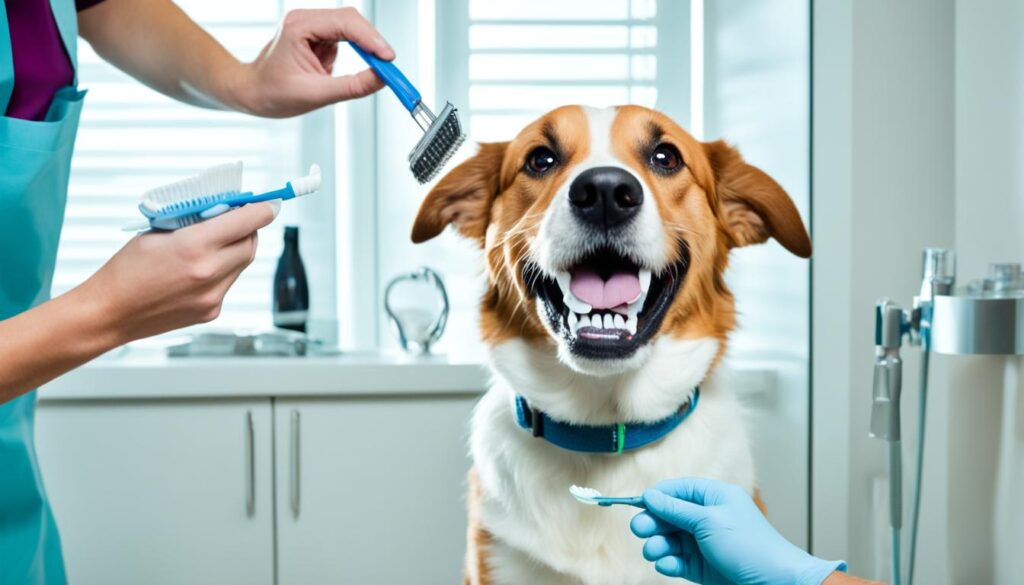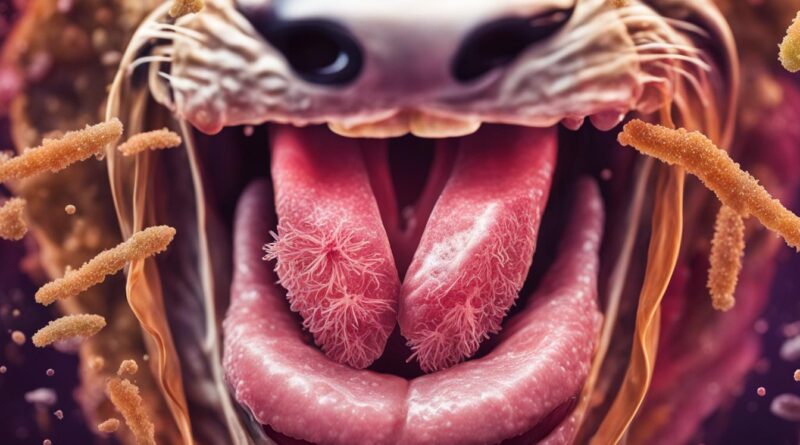Do Dogs Have the Cleanest Mouths? Myth Busted
Contrary to popular belief, a dog’s mouth is not necessarily cleaner than a human’s. The myth that dogs have the cleanest mouths has been debunked. While dogs do have their own unique oral hygiene needs, their mouths are just as full of bacteria as humans. It’s important to understand the facts about dog mouth cleanliness to ensure proper dental hygiene in dogs.
Key Takeaways:
- A dog’s mouth is not cleaner than a human’s.
- Both dogs and humans have bacteria in their mouths.
- Dog bites can lead to infections, indicating the presence of harmful bacteria.
- Proper dental care is essential for maintaining oral health in dogs.
- Regular dental check-ups and at-home oral hygiene practices are important for dogs.
The Oral Microbiome of Dogs and Humans
Each species, including dogs and humans, has its own oral microbiome, which refers to the collection of microorganisms present in the mouth. Humans have an oral microbiome consisting of approximately 400 to 500 bacterial species, while dogs have around 400 bacterial species in their oral microbiome. Dogs and humans share only about 15% of the oral microbiome, meaning that the majority of bacterial species found in each species’ mouth are distinct.
The oral microbiome plays a crucial role in maintaining oral health. It consists of various bacteria, fungi, and viruses that coexist in a delicate balance. While some microbes can be pathogenic and contribute to dental diseases, others are beneficial and help protect against harmful invaders.
Diversity in the Oral Microbiome
The oral microbiome is a highly diverse ecosystem. It is influenced by multiple factors, including genetics, diet, oral hygiene practices, and overall health. Each individual has a unique oral microbiome, shaped by these factors.
In humans, the oral microbiome is primarily composed of bacterial species, with the most common phyla being Firmicutes, Bacteroidetes, Actinobacteria, and Proteobacteria. These bacteria play essential roles in maintaining oral health, such as breaking down food particles, aiding in digestion, and regulating the pH balance in the mouth.
In dogs, the oral microbiome also consists predominantly of bacteria, with similar phyla to those found in humans. However, there are differences in the specific bacterial species present. For example, Fusobacteria and Spirochaetes are more abundant in dogs compared to humans. These species are adapted to the unique oral environment of dogs and perform specific functions necessary for their oral health.
It’s worth noting that the oral microbiome is not static and can change over time. Factors such as age, diet changes, and the use of antibiotics can alter the composition of the oral microbiome in both dogs and humans.
The Interaction Between Oral Microbiomes
While dogs and humans share some similarities in the composition of their oral microbiomes, the majority of bacterial species are unique to each species. This distinct microbial composition prevents most bacteria from dogs to colonize and cause infections in humans, and vice versa.
However, there are instances where bacteria found in a dog’s mouth can be transmitted to humans and cause infections. This typically occurs through bites, as certain bacteria can be present in a dog’s saliva. Capnocytophaga canimorsus and Pasteurella canis are examples of bacteria commonly found in dog mouths that have been associated with human infections.
It is important to note that the risk of infection from the oral microbiome is generally low for individuals with a healthy immune system. Good hygiene practices, such as regular handwashing, can further minimize the risk of bacterial transmission between dogs and humans.
Understanding the oral microbiome of dogs and humans provides valuable insight into the complex microbial ecosystems present in our mouths. Further research in this field can help develop more effective strategies for maintaining oral health in both species and potentially identify novel approaches to prevent and treat dental diseases.
Bacteria and Infections in a Dog’s Mouth
It is important to recognize that a dog’s mouth is not sterile, and it contains various bacteria that can potentially cause infections in humans. Two types of bacteria commonly found in a dog’s mouth are Capnocytophaga canimorsus and Pasteurella canis. These bacteria can be transmitted to humans through bites, leading to serious bacterial infections, especially in individuals with compromised immune systems.
Dog saliva also carries the risk of transmitting viral illnesses, such as rabies. While the overall risk of infection from dog saliva is generally low, it is still crucial to take precautions and seek medical attention if bitten.
Dangerous Bacteria in a Dog’s Mouth
The bacteria Capnocytophaga canimorsus is commonly found in the oral cavity of dogs and cats, and it can cause severe infections in humans if it enters the bloodstream. Although rare, it can lead to serious conditions, such as sepsis, meningitis, or endocarditis, particularly in individuals with weakened immune systems or those who have had splenectomy.
The bacteria Pasteurella canis is another common inhabitant of a dog’s mouth. It can cause localized infections, such as skin and soft tissue infections, as well as respiratory tract infections, especially in people who have been bitten or scratched by an infected dog.
Precautions and Medical Attention
If you or someone you know is bitten by a dog, it is essential to take immediate precautions and seek medical attention. Follow these steps:
- Wash the wound with soap and warm water for at least five minutes to reduce the risk of infection.
- Apply an antiseptic solution or ointment and cover the wound with a clean bandage to protect it from further contamination.
- Contact a healthcare professional to evaluate the bite and determine if additional measures, such as tetanus vaccination or antibiotic treatment, are necessary.
It is also crucial to monitor the wound for signs of infection, such as increased redness, swelling, warmth, or drainage. If any of these symptoms occur or if there is persistent pain, it is important to seek medical attention promptly.
Remember, proper wound care and medical attention can help prevent complications and ensure your well-being after a dog bite.
Although the risk of infection from dog bites is relatively low, it is always better to err on the side of caution and seek medical attention to prevent any potential complications.
To illustrate the presence of harmful bacteria in a dog’s mouth, here is a table showcasing common bacteria found in a dog’s oral cavity:
| Bacteria Species | Role |
|---|---|
| Capnocytophaga canimorsus | Potential cause of severe infections in humans |
| Pasteurella canis | Commonly associated with localized infections |
| Fusobacterium nucleatum | Contributor to periodontal disease in dogs |
| Tannerella forsythia | Associated with canine periodontitis |
The Role of Saliva in Wound Healing
Saliva, including dog saliva, possesses healing properties that can aid in wound healing and prevent infection. Saliva contains proteins called histatins and antibacterial peptides, which have antibacterial properties and can help combat harmful bacteria in wounds.
When a dog licks a wound, the mechanical action of licking can remove debris and promote cleanliness. Additionally, dog saliva contains enzymes that can help break down bacteria and boost the body’s natural healing process.
“Saliva contains antibacterial properties that can help prevent infection in wounds.”
However, it is important to note that while dog saliva has certain healing properties, it is not recommended to let a dog lick a wound. There is still a potential risk of introducing more bacteria into the wound, which can lead to infections. It is best to clean the wound with clean water or a mild antiseptic and seek professional medical advice for appropriate wound care.
It is worth mentioning that the healing properties of saliva are not exclusive to dogs. Other mammals, including humans, also have saliva that contains similar healing properties.
To give you a visual reference, here’s an image related to wound healing:

Dogs Saliva and Wound Healing: Separating Fact from Fiction
There is a common misconception that dog saliva has healing properties that can miraculously cure wounds. While there are some truths to the healing properties of saliva, it is essential to understand the limitations and potential risks.
The antibacterial properties of dog saliva, combined with its natural cleansing abilities, can contribute to the wound healing process. However, it is crucial to prioritize proper wound care practices, follow medical advice, and maintain good hygiene to prevent infections and promote effective healing.
Proper Dog Oral Care
Proper dental care is crucial for maintaining a dog’s oral health. Regular dental check-ups are recommended, with at least one dental appointment per year. During these check-ups, a veterinarian can perform a thorough oral examination, identify any dental issues, and provide appropriate treatments.
Daily tooth brushing using a dog-friendly toothpaste is an essential part of maintaining good oral hygiene. Brushing helps remove plaque and tartar buildup, preventing dental issues such as gum disease and tooth decay. It is crucial to use a toothpaste specifically formulated for dogs, as human toothpaste can be harmful if ingested by dogs.
In addition to tooth brushing, there are other products and techniques that can aid in cleaning a dog’s teeth. Plaque prevention products, such as dental rinses or water additives, can help reduce plaque and tartar buildup. Dental chews and toys designed to promote chewing can also assist in tooth cleaning by removing debris and stimulating saliva production, which helps fight bacteria.
Feeding a special dental diet can also contribute to maintaining a clean and healthy mouth for dogs. Dental diets are formulated with specific kibble sizes and textures to promote chewing and reduce plaque accumulation. These diets often contain ingredients that help prevent tartar buildup and freshen breath.

A comprehensive dental care routine involves multiple components, including professional dental cleanings, daily tooth brushing, plaque prevention products, dental chews, toys, and a specialized dental diet. Implementing these practices can significantly improve a dog’s oral health and overall well-being.
Remember, just like humans, dogs can also experience dental issues that require professional treatment. Regular dental check-ups and cleanings, along with a diligent at-home dental care routine, are essential for maintaining a healthy and clean mouth for your furry friend.
Risks of Dog Saliva and Hygiene Practices
While having contact with dogs is generally safe, it’s important to be aware of the potential risks associated with dog saliva and practice good hygiene. Dog saliva can contain bacteria that may lead to infections if proper precautions are not taken. Here are some essential hygiene practices to follow:
1. Washing the Area
If you are licked by a dog, it’s recommended to wash the area thoroughly with soap and warm water. This helps remove any potential bacteria that may be present on the skin.
2. Cleaning Dog Bites
In the event of a dog bite, immediate and thorough cleaning is crucial. Clean the wound with soap and water for at least 15 minutes. Pay attention to deep wounds, those that bleed profusely, or are located in concerning areas. Seeking medical attention is advisable to assess the severity of the wound and receive appropriate treatment.
3. Maintaining General Hygiene
Apart from specific incidents, practicing good hygiene after contact with dogs is essential. This includes regularly washing your hands with soap and water, especially before meals, to minimize the risk of potential infections.
| Hygiene Practices | Benefits |
|---|---|
| Washing hands after dog contact | Reduces the risk of infection |
| Keeping wounds clean and covered | Prevents bacterial contamination and promotes healing |
| Regularly cleaning dog toys and bedding | Reduces the chances of spreading bacteria or parasites |
| Practicing proper dog oral care | Maintains oral health and minimizes bacterial buildup |
Following these hygiene practices can help minimize the potential risks associated with dog saliva and ensure a safe and healthy interaction with our furry companions.
Importance of Professional Dog Dental Cleaning
Professional dental cleaning is a crucial aspect of ensuring optimal oral health for dogs. Regular cleanings administered by a qualified veterinarian offer numerous benefits and can effectively prevent and address a range of dental issues commonly faced by our furry friends.
During a professional dental cleaning, the veterinarian conducts a comprehensive examination of the dog’s mouth, checking for any signs of dental problems such as plaque buildup, tartar, or periodontal disease. This thorough assessment allows for early detection and intervention, preventing potentially serious complications.
| BENEFITS OF PROFESSIONAL DOG DENTAL CLEANING |
|
|---|---|
| 1. Preserves Oral Health | Regular cleanings help maintain clean teeth and healthy gums, reducing the risk of tooth decay, gum disease, and other dental issues. |
| 2. Prevents Plaque Buildup and Tartar | Dental cleanings remove plaque and tartar, which can contribute to bad breath and dental diseases. |
| 3. Addresses Periodontal Disease | Early detection and treatment of periodontal disease can prevent tooth loss and potentially serious health complications. |
| 4. Enhances Overall Well-being | A healthy mouth promotes overall health and reduces the risk of systemic infections that can affect vital organs. |
Professional dental cleanings typically involve a range of procedures, including teeth cleaning, polishing, and the potential use of X-rays and fluoride treatment. These interventions are tailored to each dog’s specific needs and provide a complete and effective dental care experience.
If left untreated, dental issues in dogs can lead to significant pain and discomfort, affecting their ability to eat and enjoy life. By prioritizing professional dental cleaning, we can ensure that our beloved canine companions maintain excellent oral health, leading to a happier and healthier life.
Conclusion
In conclusion, the notion that dogs have the cleanest mouths is a popular misconception that has been debunked. While it is true that dogs have a different oral microbiome compared to humans, their mouths are not inherently cleaner. Studies have shown that a dog’s mouth contains bacteria, and some of these bacteria can potentially cause infections in humans.
To maintain a dog’s oral health, proper dental care is crucial. Regular dental check-ups with a veterinarian, at least once a year, are recommended to identify and address any dental issues. Additionally, practicing good oral hygiene at home, such as daily tooth brushing with dog-friendly toothpaste, using plaque prevention products, and providing dental chews or special dental diets, can help prevent plaque buildup and ensure a clean and healthy mouth for dogs.
While it is generally safe to be licked by a dog, it’s important to take precautions to ensure hygiene and minimize the risk of potential infections. After contact with a dog, it is advisable to wash the area with soap and warm water. In the case of a dog bite, thorough cleaning with soap and water for at least 15 minutes is necessary, followed by seeking medical attention if the wound is deep, bleeding profusely, or in a concerning location. By following proper hygiene practices, we can further reduce the risk of infections associated with dog saliva.
FAQ
Do dogs have cleaner mouths than humans?
No, contrary to popular belief. A dog’s mouth is not necessarily cleaner than a human’s. Both contain bacteria, although the types of bacteria may differ.
How many bacterial species are found in a dog’s mouth?
Dogs have about 400 bacterial species in their oral microbiome, which is the collection of microorganisms in the mouth.
Do dogs and humans share the same oral microbiome?
No, only about 15% of the oral microbiome is shared between dogs and humans. The majority of bacterial species found in each species’ mouth are distinct.
Can bacteria in a dog’s mouth cause infections in humans?
Yes, certain bacteria commonly found in a dog’s mouth, such as Capnocytophaga canimorsus and Pasteurella canis, can be transmitted to humans through bites and cause infections.
Does dog saliva have healing properties?
Yes, dog saliva contains proteins and antibacterial peptides that can help prevent infection in wounds. However, it is still not advisable to let a dog lick a wound due to the potential risk of infection.
How can I take care of my dog’s oral health?
Regular dental check-ups, daily tooth brushing with a dog-friendly toothpaste, and the use of plaque prevention products, dental chews, or special diets can help maintain a clean and healthy mouth for dogs.
What should I do after being licked by a dog?
It is advisable to wash the area with soap and warm water to ensure hygiene. Although the risk of infection from dog saliva is generally low, good hygiene practices help reduce potential infections.
Why is professional dog dental cleaning important?
Professional dental cleanings conducted by a veterinarian are crucial for preventing and addressing dental issues, such as plaque buildup, tartar, and periodontal disease, which can cause pain and discomfort for dogs if left untreated.
Is it true that dogs have the cleanest mouths?
No, the belief that dogs have the cleanest mouths is a myth. A dog’s mouth contains bacteria, and certain bacteria can cause infections in humans. Proper dental care and hygiene practices are essential.


